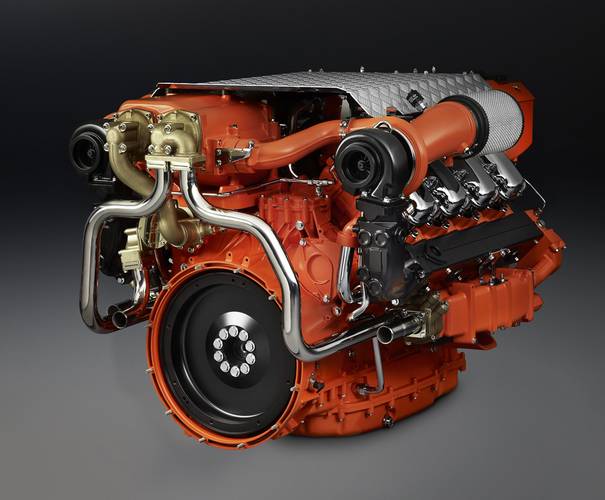Scania Unveils the Future
1,000 hp V8 Engine Launched in New Orleans
Building on Scania’s new global engine platform is the 16-liter marine V8, delivering up to 1,000 hp and 2,460 Ib./ft. for patrol craft applications, a compact power source that leverages technology and architecture with Scania’s truck and bus engines.
“The new 16 liter engine has gone up in horsepower for each duty cycle we offer, which means that we can approach larger vessels,” said Mikael Lindner, President, Scania U.S.A. Inc. “It also means is that this engine is now able to compete with a 18-24 liter engines, which is a huge benefit because you can get a smaller engine, that is lighter with great power, and better fuel consumption.”
Central to the Scania line and this powerplant in particular is adherence to high power-to-weight ratio, a critical factor in the marine market for easy installation, refit and performance. “One of the criteria’s when developing the new 16 was that it should be easily interchangeable with the current 16,” said Lindner. “When you re-power the predecessor, it’s plug and play.”
The official North American launch was in New Orleans early last month, where the company showcased its new 16 and 13-liter engines, as well as the enhanced instrumentation.
Besides the new 16-liter V8, Scania’s marine engine range includes a 13-liter inline six-cylinder unit launched in 2011, an engine intended for propulsion and auxiliary use.
Each engine in the new range is designed for higher strength and durability, and many components are shared across the range, significantly reducing the number of unique parts per engine and assisting in the repair and maintenance of the unit.
“We use a modular design on the 13 liter and 16 liter engines, which have the same cylinder head, the same combustion chamber and the same liners. Scania develops a single cylinder engine with one combustion chamber, and then adds cylinders as needed”
Scania has a history of conducting basic engine development and manufacturing, as well as the development of engine management, fuel injection and emission control systems in-house, a strategy it sees as central to its goals in fuel economy, environmental performance and robustness.
16-liter V8s from 550 to 1,000 hp
The output of the new 16-liter marine engines spans from 550 hp for continuous use to 1,000 hp for patrol craft use. The ratings have been uprated for planing and displacement vessels, and the company’s engines are competitive with engines above the 16-liter threshold. Of particular note is the torque rating of up to 2,463.5 lb./ft., a high number for this output class. Engine rooms, particularly on smaller vessels, are generally ‘space challenged,’ and Scania sees to it that its engines produce high power from compact packages, enabling quick refit and easy servicing while maintaining a robust structure needed in the maritime market. Each cylinder has its own head, and together with wet cylinder liners, it makes for easy overhauls in confined spaces. Additionally, the camshaft is located high in the block and the timing gears are rear-mounted. For these reasons, most repairs and servicing can be carried out by a single service technician. The Scania Saver ring, placed at the top of each cylinder liner, reduces carbon deposits on the edge of the piston crown and reduces cylinder liner wear.
“We try to keep the engine clean and simple. We try to minimize piping and filters, to promote serviceability and the one man service concept” said Lindner.
13-Liter
The 13-liter marine engines range from 400 hp for continuous use up to 750 hp for patrol craft use, and the Scania 13-liter marine engine is the first in a new line of engines for propulsion and auxiliary use. Torque ratings have been increased on the new range, making it easier to maintain favorable operating speeds in high sea or with a heavy load. Single-circuit keel cooling is used to simplify installation and reduce cost.
For marine auxiliary use, the Scania 13-liter engine is designed to handle large step- load variations with short recovery time. The top version achieves its top output of 426 kW at 1,800 rpm. The engine also features Scania EMS, an in-house developed engine management system that is designed to be flexible when it comes to tailoring engine performance to individual customer applications.
The new 13-liter marine engines complies with emission standards IMO II, EU Stage IIIA and US Tier 2.
“What you’re seeing here is the engine platform that will be used for Tier III,” said Lindner. “The 13 liter engine was introduced earlier this year and it replacing the 12 liter engine. The new 16-liter engine is being introduced at this show.
Scania also launched a new type-approved instrumentation according to the standards of classification societies such as RINA, DNV, Germanischer Lloyd, American Bureau of Shipping and Lloyd’s Register. The new instrumentation is designed to be easy to install and via a user-friendly and flexible web interface, the marine operator can adapt the information on the panels and choose any required data. The panels have prepared layouts for water temperature, engine speed, oil pressure and fuel consumption. The operator can also connect and configure a gauge indicator for transmission monitoring and for fuel or fresh-water levels.
The master panel is equipped with a flexible input/output (I/O) with ten digital inputs, two 4-20 mA inputs, two PT100 inputs and seven digital outputs. The system is expandable with an unlimited number of slave panels via standard Ethernet. The flexible I/O makes it easy to install surveillance and alerts of seawater flow or fuel consumption. Increased idling makes the maneuvering of a hydraulic pump for powering winches, or cranes, uncomplicated. Connection for throttle availability via all standardized interfaces (0-5 V, 4-20 mA and CAN).
(As published in the January 2013 edition of Maritime Reporter- www.marinelink.com)














